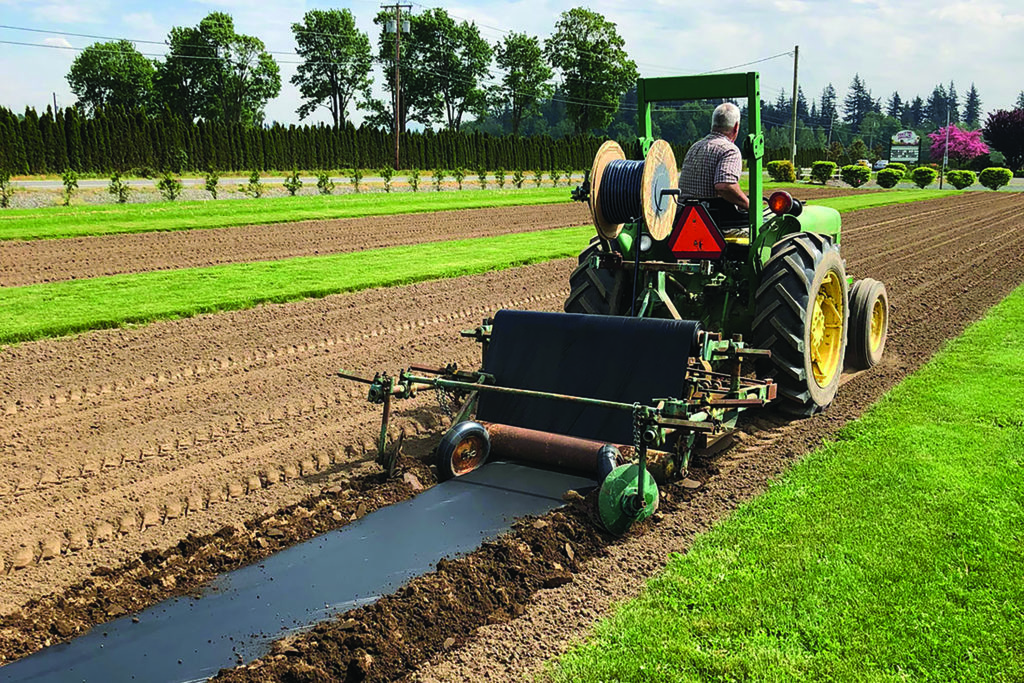

Mar 18, 2019Biodegradable mulch lessens labor pressure
Plastic mulch helps control weeds, conserve moisture and speed soil warmup – to name a few advantages – but biodegradable plastic mulch offers that and potentially even more.
“Plastic mulch is a very common tool around the U.S. and around the world, but what are some alternatives to plastic mulch and what can mulch do for your soils?” asked Carol Miles, professor in vegetable horticulture at Washington State University (WSU). Miles was a speaker at the recent Great Lakes Fruit, Vegetable and Farm Market EXPO in Grand Rapids, Michigan.
Many growers are hesitant to adopt biodegradable plastic mulches because of concerns over uncertainty, risk and aesthetics.
WSU is completing the fourth year of a study evaluating biodegradable plastic mulch. If it performs as envisioned, the mulch completely biodegrades without harm to the soil or the environment and offers benefits equal to polyethylene mulch. Biodegradable plastic mulch has lower labor costs because it doesn’t have to be removed and disposed of at the end of the season – an important consideration because of its higher cost.
“You till it in at the end of the season,” Miles said. “The big advantage of biodegradable plastic mulch is it saves on labor.”
WSU is evaluating biodegradable plastic mulches at Mount Vernon, Washington, and with the University of Tennessee at Knoxville, Tennessee. Working at two locations has already determined the rate of mulch deterioration – measured as the percent of soil exposure (PSE) through the season – is much different at different sites and varies with the year. In general, expect faster deterioration in years with more moisture and higher temperatures.
At Knoxville in 2016, all products held up well with about a 20 percent PSE on Sept. 1. However, heavy rains and high temperatures in 2015 made some products fall apart with near 100 percent PSE by mid-summer.
At Mount Vernon, with Washington’s cooler temperatures, the biodegradable products held up even better in 2016 with PSEs around 5 percent on Sept. 1. In 2015, only one biodegradable product fell apart and had PSE up to around 60 percent by Sept. 1, but this was because the product was folded in half by the manufacturer, and the fold was a weakness that caused the rapid deterioration.
Location matters


horticulture at Washington State
University said all of the black,
biodegradable plastic mulches yield
comparably to black, polyethylene
mulch. Photo: Dean Peterson
“The location, not the crops, determines the amount of degradation,” Miles said. “You really need to test these products on your farm to see which of these products works for you. Having enough mulch intact through the length of the growing season is very important for weed control.”
Solid results on comparisons of weed control were difficult to come by. “There was a mixed response on weed control because weed pressures are different at different sites,” Miles said. “There are more issues affecting weed control than just mulch.”
Yield is a more consistent message. “The site is what’s really going to determine yield,” Miles said. “All of the black, biodegradable plastic mulches had comparable yields to black, polyethylene mulch.”
WSU has been testing the products BioAgri, Exp.PLA/PHA (an experimental film), Naturecycle, Organix (black), Organix Clr (clear), standard polyethylene and WeedGuardPlus.
The products vary in their bio-based percentage. BioAgri is 20 to 25 percent bio-based, Exp.PLA/PHA is 86 percent bio-based
and Naturecycle is equal to or greater than 20 percent bio-based. Organix and Organix Clr are 10 percent bio-based while polyethylene is less than one percent bio-based and WeedGuardPlus is 100 percent bio-based. WeedGuardPlus is paper, 100 percent biodegradable, and allowable for use in certified organic production.
The percentage of bio-based composition is not the determining factor in product quality or time of degradation because the mulches can be made in many ways.
Biodegradable plastics can be derived from corn starch or other plant starches or from the bacterial fermentation of plant sugars or lipids. The biodegradable polymers can also be made from synthetic products containing ester bonds which are readily broken down by microorganisms, sunlight and water.
A sticky situation
Biodegradable plastic mulch has a reputation of sticking to heavy fruit and causing problems with visible appearance.
The WSU study used pumpkins in the trials to assess that problem.
The problem did emerge and the mulch did stick to the pumpkins. In a new study, Miles found the mulch fragments could be wiped off the fruit if the fruit was slightly damp when it was picked due to humidity, dew or irrigation and the fruit was wiped immediately. “If you have a food grade product going out of your field, you’re not going to want to take the time to try to wash it off,” Miles said. “Consider biodegradable plastic mulch carefully if you’re in this situation.”
WeedGuardPlus in the study was found to have a cooling effect on the soil, which had a negative effect in Washington’s cool climate. In warmer parts of the country, the cooling effect could be positive.
WeedGuardPlus also had the ability to control yellow nutsedge. “It controlled yellow nutsedge every year in the trial,”
Miles said. “We feel this is very important for growers who have that problem. There are no postemergence herbicides labeled for pumpkins so weed control is a real issue.”
Deterioration vs. degradation
When assessing biodegradable mulches, it’s important to understand the difference between deterioration and degradation.
Degradation is actual decomposition.
Deterioration is weather damage or rips and tears from improper handling.
“If the mulch is drawn too tight over the crop it tends to pull apart,” Miles said. “The key is to alleviate any tension on your mulch.”
Tips on collecting and measuring mulch fragments from the soil – to assess how well a product works for you – are available at www.biodegradablemulch.org. The site is a partnership of the University of Tennessee, WSU and Montana State University.
“You have to do your due diligence when collecting and measuring these samples,” Miles said. “Mulches are going to perform differently at each site.”
Oxo- or photo-degradable plastic mulch is a serious issue in the discussions on biodegradable plastic mulch.
“It’s being marketed as a biodegradable plastic and it’s not,” Miles said. “What you’re going to end up with is plastic pollution in your field. It won’t decompose and will be there for 300 years like polyethylene mulch. You can’t pick it up; it just crumbles apart.”
A guidance document on oxo- or photodegradable plastic mulch is available at www.biodegradablemulch.org.
– Dean Peterson, VGN Correspondent
Above: Researchers lay mulch at Boxx Berry Farm in Ferndale, Washington, where Washington State University researchers are studying biodegradable mulches. Photo: Washington State University














